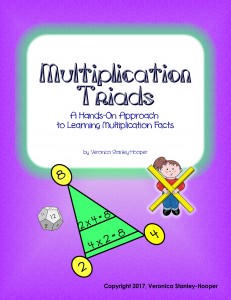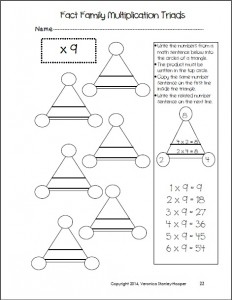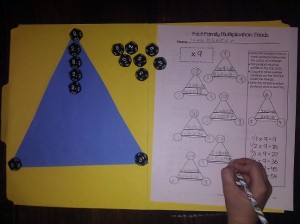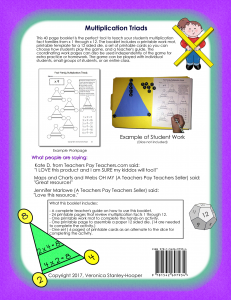Anyone out there remember School House Rock? Well, I used the SchoolHouse Rock videos found on YouTube in combination with my new booklet, Multiplication Triads (affiliate link) and flash cards to teach my daughter multiplication facts. By using these three different strategies my daughter was able to memorize the multiplication facts to twelve in under two weeks. You can too.
We got started by playing the Multiplication Triads game for the number one. Each number (1-12) has two pages in the booklet. The first page covers a number multiplied by 1 through 6 and the second page covers that same number multiplied by 7 through 12. On day one we did all of the multiplication facts for the number one. Then we wrote a flash card for each multiplication sentence (1×1=1 through 1×12=12.)
The next day we reviewed facts for number one by playing the Multiplication Triads game again and reviewing the flash cards we made the previous day. Then we practiced the next number in the Multiplication Triads game (in this case, the number two) and completed the lesson by writing out flash cards for number two. We worked in this way through the entire Multiplication Triads booklet for twelve school days.
We were able to integrate the SchoolHouse Rock videos when we did numbers three through twelve. (SchoolHouse Rock has no video for one or two, but they do have videos for zero and three through twelve. We found “Figure 8” one of the most helpful videos.)
By this time you may be wondering what is the Multiplication Triads game all about. Multiplication Triads associates the three numbers that work together to make up a fact family for each multiplication fact. There is a triangular work mat that is used to organized cards or dice that represent the numbers in the multiplication fact the student is trying to memorize. Each number has a set of two work pages that work through the multiplication facts 1-12 for that number. The student fills in the triads on the work pages to memorize the numbers associated with each multiplication fact’s family of numbers.
Here’s what people are saying about my Multiplication Triads booklet:
- Kate D. from Teacher Pay Teachers.com said: “I LOVE this product and I am SURE my kiddos will too!”
- Maps and Charts and Webs OH MY (A Teachers Pay Teachers Seller) said: “Great resource!”
- Jennifer Marlowe (A Teachers Pay Teachers Seller) said: “Love this resource.”
Here’s what the booklet includes:
This 40 page booklet is the perfect tool to teach your students multiplication fact families from x1 through x12.
The booklet includes:
– 24 work pages to play the game
– a work mat page
– a page with a template for a ‘make-your-own’ 12 sided die*
– 6 pages of number cards that can be cut out or reprinted for multiple students*
– a teacher’s guide
Work pages can also be used independently of the game for extra practice or homework.
*The die template and printable cards are included so you can choose how students play the game.
The game can be played with individual students, small groups of students, or an entire class.
*hard plastic dice are not included.
You can find your copy to purchase in two convenient ways.
 |
 |
| Amazon.com Soft cover(affiliate link) | Teachers Pay Teachers (digital download) |
Did you know that by using different strategies to learn facts (reading, playing a game, listening to music, watching a video) you are engaging more parts of your brain in the learning experience? Using different parts of your brain to learn a skill makes it easier to memorize the information and recall the information later. By employing the three strategies above (Multiplication Triads, SchoolHouse Rock and Flash cards) you are increasing your child’s ability to memorize multiplication facts and reducing the amount of time that it takes to do so.
I can’t wait to hear about your experiences with teaching your children multiplication. Comment below! 🙂



